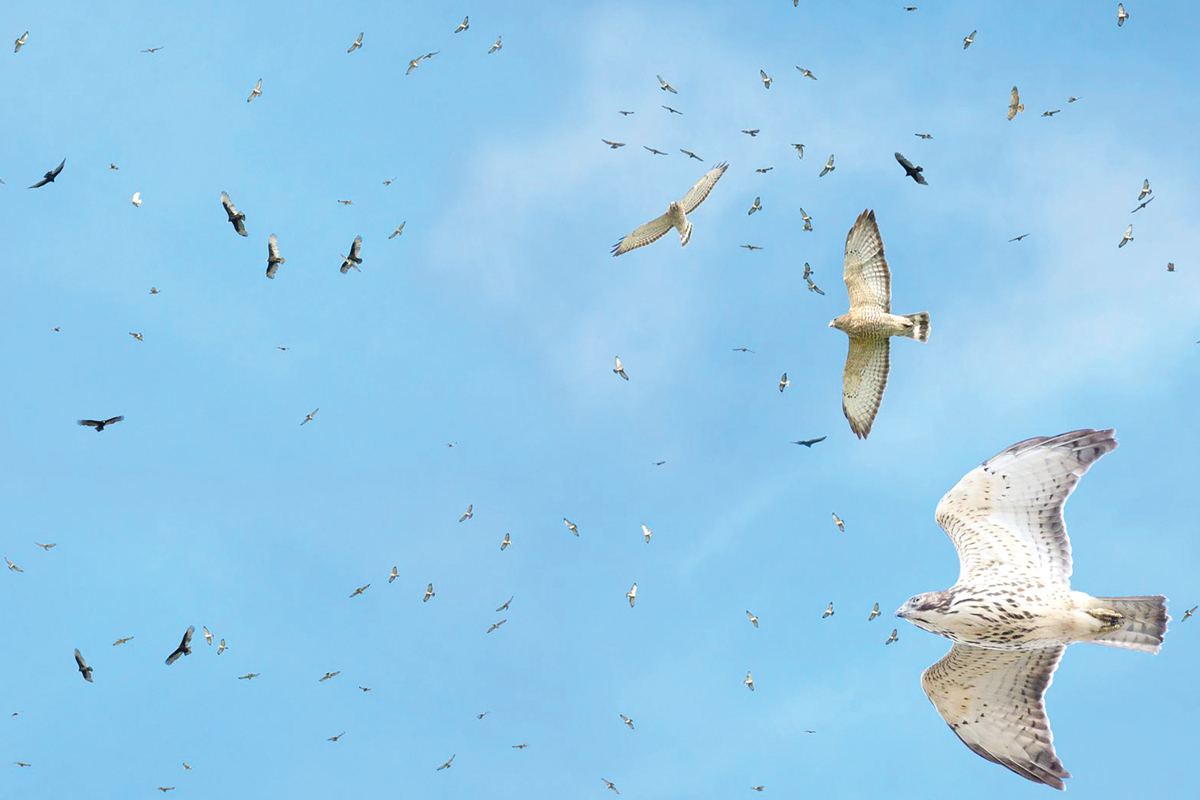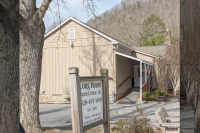Coming Soon: The broad-winged hawk migration
 From mid to late September, hundreds of broad-winged hawks pass over Western North Carolina and East Tennessee in large groups called “kettles,” circling higher and higher into the air currents and moving south along the Blue Ridge Mountains. Richard Crossly photo
From mid to late September, hundreds of broad-winged hawks pass over Western North Carolina and East Tennessee in large groups called “kettles,” circling higher and higher into the air currents and moving south along the Blue Ridge Mountains. Richard Crossly photo
As we prepare for the arrival of fall, we can also be on the lookout for a breathtaking wildlife spectacle that is a part of life here in the Southern Appalachian Mountains: the migration of the broad-winged hawk.
Small forest-dwelling birds of prey, broad-winged hawks migrate annually to South and Central America from their breeding grounds in North America’s temperate forests. Residents of Western North Carolina and East Tennessee have the opportunity to see hundreds of birds at a time moving south along the Blue Ridge Mountains.
“This migration occurs throughout September and early October with peak numbers usually occurring between September 19 and 26,” says Jeffrey Hunter, Southern Appalachian director for the National Parks Conservation Association. “Last year I saw over 3,000 birds in two hours at the Mount Pisgah Hawk Watch at Mills River Overlook, mile marker 404.5 along the Blue Ridge Parkway.”
Hunter says another great place to see migrating broad-winged hawks is Grandfather Mountain. These regional high-elevation lookout points also offer the chance to see bald eagles, peregrine falcons, northern harriers and Cooper’s hawks, among others.
Not surprisingly, the best areas in the Great Smoky Mountains National Park to watch for fall flights of the broad-winged hawk are also vantage points in the higher elevations including Newfound Gap, Indian Gap and Clingmans Dome (known to the Cherokee as Kuwohi, “Mulberry Place”), according to the Great Smoky Mountains Association’s field guide “Birds of the Smokies.”
Related Items
Look Rock fire tower on the Foothills Parkway provides a sweeping 360-degree panoramic view of the stunning Smoky Mountain landscape from which to watch these hawks and other species in migration. Kristine Johnson, volunteer curatorial assistant with the Smokies, says the Knoxville chapter of the Tennessee Ornithological Society sometimes performs “hawkwatch” counts at Look Rock.
“I like the fact that one can’t pin an exact date on when hawks might show up in large numbers since part of their departure is based on when cold fronts move through and whatever else the hawks know that we don’t,” she says. “I’ve seen big numbers on House Mountain in Knox County as they follow north-to-south mountain ranges.”
“Birds of the Smokies” author Fred Alsop says Buteo platypterus is a fairly common summer resident of the park that can be seen at all elevations. “This is a bird of the deciduous woodlands that often hunts from low perches … The broadly banded dark and white tail is characteristic, with the white bands being about equal in width to the dark ones. During its summer stay with us, I have often been aware of the broad-winged hawk’s presence by its thin, shrill pee-weeeeee whistled call.”

The broad-winged hawk is a fairly common summer resident in the Smokies, and can be seen hunting from low perches in deciduous woodlands. Aitor Gonzalo photo
The Great Smoky Mountains National Park’s first naturalist, Arthur Stupka, collected phenological information about birds and other wildlife from 1935 to 1960. In his “Notes on the Birds of Great Smoky Mountains National Park,” he recorded that “from April, when the Broad-wings arrive, through August, the numbers of this hawk in the park are approximately the same as the numbers of Red-tails. For the 20-year period beginning in 1934, the migrant Broad-wings observed here during that five-month period totaled 223; the permanent resident Red-tails, 249. In September, however, the passage of migrating Broad-wings over the park results in a striking change, their numbers exceeding those of their larger cousins by 10 to 1 (451 to 45) during that month.”
Smokies Science Coordinator Paul E. Super says, “Broad-winged hawks are noteworthy in that they all seem to migrate in just a few days, and one sees big ‘kettles’ of them wheeling around to get into a better air current.” He mentioned that last September several National Park Service staff and visitors were treated to the awesome display on National Public Lands Day, September 24, 2022.
“We had NPS Director Chuck Sams and some other VIPs from the NPS and Health and Human Services visiting the park,” remembers Education Branch Coordinator Susan Sachs. “After leaving Oconaluftee, the group came up to Purchase Knob to meet with a group of Cherokee High School students, some cultural experts from the Museum of the Cherokee Indian, and some staff from the Tribal Historic Preservation Office.”
From the porch of the Appalachian Highlands Science Learning Center at The Purchase, Sachs started noticing that large kettles of broad-winged hawks were catching the thermals above the assembled humans.
“They would fly in from the north, get to where we were, climb higher and then continue their path to the south,” she recalls. “I estimate that each kettle had about 25 to 50 hawks in it — and at least one group had a bald eagle. I saw about five kettles come through, but I know they probably were coming through before and after I noticed them.”
Hesitant to interrupt the VIP’s discussion, Sachs eventually pointed out the birds to the participants. Everyone grabbed binoculars, and the natural event took center stage for a while.
“I was up there again the next day and didn’t see even one broad-winged hawk,” Sachs says. “Timing is everything.”
If you would like to get prepared to spot hawks migrating this fall, a great online resource is the Hawk Migration Association of North America’s Raptor Migration Database at hmana.org. It allows you to select your “hawkwatch” location and then track and upload your sightings.
“Depending on the weather, it can be hit or miss,” Hunter says, “but when timing is right, you can be rewarded with hundreds or even thousands of birds.”
(Frances Figart (rhymes with “tiger”) is the editor of “Smokies Life” and the Creative Services Director for the 29,000-member Great Smoky Mountains Association, an educational nonprofit partner of Great Smoky Mountains National Park. This piece was written as part of GSMA’s “Word from the Smokies” series of columns on the natural and cultural wonders of the Great Smoky Mountains National Park. Reach Figart at This email address is being protected from spambots. You need JavaScript enabled to view it..)









